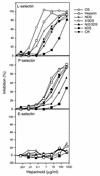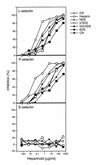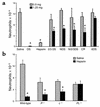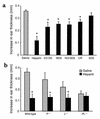Heparin's anti-inflammatory effects require glucosamine 6-O-sulfation and are mediated by blockade of L- and P-selectins
- PMID: 12093896
- PMCID: PMC151027
- DOI: 10.1172/JCI14996
Heparin's anti-inflammatory effects require glucosamine 6-O-sulfation and are mediated by blockade of L- and P-selectins
Abstract
Heparin has been used clinically as an anticoagulant and antithrombotic agent for over 60 years. Here we show that the potent anti-inflammatory property of heparin results primarily from blockade of P-selectin and L-selectin. Unfractionated heparin and chemically modified analogs were tested as inhibitors of selectin binding to immobilized sialyl Lewis(X) and of cell adhesion to immobilized selectins or thrombin-activated endothelial cells. Compared with unfractionated heparin, the modified heparinoids had inhibitory activity in this general order: over-O-sulfated heparin > heparin > 2-O,3-O-desulfated > or = N-desulfated/N-acetylated heparin > or = carboxyl-reduced heparin > or= N-,2-O,3-O-desulfated heparin >> 6-O-desulfated heparin. The heparinoids also showed similar differences in their ability to inhibit thioglycollate-induced peritonitis and oxazolone-induced delayed-type hypersensitivity. Mice deficient in P- or L-selectins showed impaired inflammation, which could be further reduced by heparin. However, heparin had no additional effect in mice deficient in both P- and L-selectins. We conclude that (a) heparin's anti-inflammatory effects are mainly mediated by blocking P- and L-selectin-initiated cell adhesion; (b) the sulfate groups at C6 on the glucosamine residues play a critical role in selectin inhibition; and (c) some non-anticoagulant forms of heparin retain anti-inflammatory activity. Such analogs may prove useful as therapeutically effective inhibitors of inflammation.
Figures







References
-
- Springer TA. Traffic signals for lymphocyte recirculation and leukocyte emigration: the multistep paradigm. Cell. 1994;76:301–314. - PubMed
-
- McEver RP, Moore KL, Cummings RD. Leukocyte trafficking mediated by selectin-carbohydrate interactions. J Biol Chem. 1995;270:11025–11028. - PubMed
-
- Lasky LA. Selectin-carbohydrate interactions and the initiation of the inflammatory response. Annu Rev Biochem. 1995;64:113–139. - PubMed
-
- Nelson RM, Venot A, Bevilacqua MP, Linhardt RJ, Stamenkovic I. Carbohydrate-protein interactions in vascular biology. Annu Rev Cell Biol. 1995;11:601–631. - PubMed
-
- Kansas GS. Selectins and their ligands: current concepts and controversies. Blood. 1996;88:3259–3287. - PubMed
Publication types
MeSH terms
Substances
Grants and funding
LinkOut - more resources
Full Text Sources
Other Literature Sources
Medical
Molecular Biology Databases

